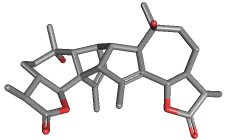|
ABSINTHIN |
| Synonyms. Absinthin; (3S-(3alpha,3aalpha,6beta,6aalpha,6bbeta,7alpha,7alphabeta, 8alpha, 10abeta, 11beta,13aalpha,13balpha,13cbeta,14bbeta))-3,3a,4,5,6,6a,6b,7,7a,8,9,10,10a,13a, 13c, 14b-Hexadecahydro-6,8-dihydroxy-3,6,8,11,14,15-hexamethyl-2H-7,13b-ethenopentaleno(1",2":6,7;5" ,4":6",7")dicyclohepta(1,2-b:1',2'-b')difuran-2,12(11H)-dione; (3s,3as,6s,6ar,6bs,7s,7ar,8s, 10as,11s,13as, 13br,13cr,14bs)-6,8-dihydroxy-3,6,8,11,14,15- hexamethyl-3,3a,4,5,6,6a,6b,7,7a,8,9,10,10a,13a,13c,14b- hexadecahydro- 2h-7,13b-ethenofuro[2'',3'':4',5']azuleno[1',2':2,3] azuleno[4,5-b]furan-2,12(11h )-dione; Absinthiin; Absynthin; |
|
|
| PRODUCT IDENTIFICATION | |
|
CAS RN |
1362-42-1 |
|
EINECS RN |
|
|
FORMULA |
C30H40O6 |
|
MOLE WEIGHT |
496.66 |
|
H.S CODE |
|
|
SMILES |
C[C@H]1[C@@H]2CC[C@]([C@@H]3[C@H]4[C@H]5C=C([C@@]6 ([C@H] 4C(=C3[C@H]2OC1= O)C)[C@@H]5[C@@](CC[C@@H]7 [C@@H]6OC(=O )[C@H]7C)(C)O)C)(C)O |
|
CLASSIFICATION |
Triterpenoid |
|
EXTRA NOTES |
Absinthin is a naturally produced sesquiterpene lactone from the plant Artemisia absinthium (Wormwood). It constitutes one of the most bitter chemical agents responsible for Absinthe's distinct taste. The compound shows biological activity and has shown promise as an anti-inflammatory agent, and should not to be confused with thujone, a neurotoxin also found in Artemisia absinthium.(Wikipedia) |
|
|
| PHYSICAL AND CHEMICAL PROPERTIES | |
|
PHYSICAL STATE. |
yellow to brown powder |
|
MELTING POINT |
179 ~ 180 C |
|
BOILING POINT |
|
|
DENSITY |
|
|
SOLUBILITY IN WATER |
Practically insoluble |
| SOLVENT SOLUBILITY | Soluble in alcohol, chloroform. |
|
VAPOR DENSITY |
|
|
log P(octanol-water) |
|
|
VAPOR PRESSURE |
|
|
AUTOIGNITION TEMP |
|
| pK |
|
|
REFRACTIVE INDEX |
|
|
FLASH POINT |
|
|
|
| STABILITY AND REACTIVITY | |
| STABILITY | Stable under normal conditions. |
|
INCOMPATIBLE MATERIALS |
Strong oxidizing agents. |
| POLYMERIZATION |
Has not been reported |
|
NFPA RATINGS |
Health: 1, Flammability: 0, Reactivity: 0 |
|
|
| EXTERNAL LINKS & GENERAL DESCRIPTION |
|
Wikipedia Linking - Absinthin Google Scholar Search - Absinthin Drug Information Portal (U.S. National Library of Medicine) - Absinthin PubChem Compound Summary - Absinthin KEGG (Kyoto Encyclopedia of Genes and Genomes) - Absinthin http://www.ebi.ac.uk/ - Absinthin http://www.ncbi.nlm.nih.gov/ - Absinthin http://www.gumbopages.com/ |
|
|
| SALES SPECIFICATION | |
|
APPEARANCE |
yellow to brown powder |
|
ASSAY |
98.0% min |
|
OPTICAL ROTATION |
+101.5° ~ +105.5° (c = 1 in CHCl3) |
|
HEAVY METALS |
20ppm max |
|
|
| TRANSPORT & REGULATORY INFORMATION | |
|
UN NO. |
Not regulated |
| HAZARD CLASS |
|
| PACKING GROUP | |
|
|
| SAFETY INFORMATION |
|
|
HAZARD OVERVIEW |
May be harmful if inhaled. May cause respiratory tract irritation. May be harmful if absorbed through skin. May cause skin irritation. May cause eye irritation. May be harmful if swallowed. |
| HAZARD CODES |
|
|
RISK PHRASES |
|
|
SAFETY PHRASES |
26-36 |
|
|
| PACKING |
|
Preserve in light-resistant and well-closed containers |
